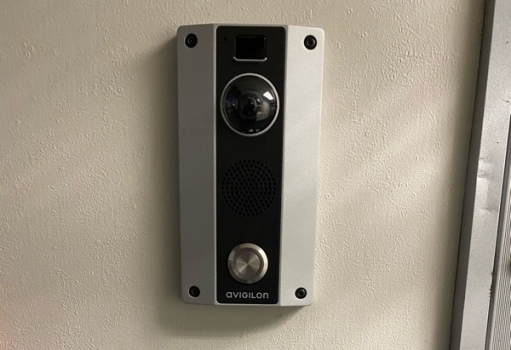Video MGMT System
 Access Control
Access Control
Voice & Data Wiring
 Burglar Alarm
Burglar Alarm
 Fire Alarm
Fire Alarm
Video MGMT System
Voice & Data Wiring
Too busy to read? Here’s a summary:
While firewalls, antivirus programs, and encryption often steal the limelight, there’s one term in the security field that’s often overlooked: access control. So, what is access control in security?
Grab a coffee, get comfy, and let's unlock this topic together!
Access control in the field of security refers to electronic systems that prevent unauthorized people from accessing physical spaces or information.
Whether securing information or physical doors, access control security systems require user credentials for identification, credential-reading devices, and preprogrammed authorization lists that credentials must be matched to before access can be granted.
The two main types of access control in the field of security are data access control, which protects information from hackers and other bad actors, and physical access control, which protects physical spaces from unauthorized intrusion.
Access control security systems:
When we talk about access control in the realm of security, it's easy to immediately think of firewalls, passwords, and encryption. But access control doesn't just live in the digital world; it has a real-world, physical counterpart as well.

Physical access control refers to measures that restrict and document physical entry into spaces like buildings, rooms, and parking garages.
Physical access control systems usually include electronic gate access control or door locks, user credentials, door readers that authenticate user credentials, and central control panels with authorization lists.
If the control panel finds a match between a presented credential and the authorization list for the site where the credential is presented, it will grant access by transmitting an electronic “unlock” signal to the access door.
Prevent Unauthorized Entry: Essentially, it's about who gets past a door or gate.
Inventory Control: If you have a storeroom of valuable items, physical access control will help to keep that inventory safe.
Data Logging: By maintaining audit trails, physical access control systems support productive investigations whenever breaches occur.
Compliance: For some organizations, like those in healthcare and finance, physical access control is required for regulatory compliance.
Like physical access control, data access control requires the input or presentation of an access credential that matches preprogrammed authorizations. But unlike its physical counterpart, data access control protects information rather than physical spaces.
As a result of this distinction, access control for data and access control for physical spaces require different hardware components. For example, an access control system for data security would be unlikely to feature physical locks and door-related hardware.
Instead, a user may scan a card or biometric credential or enter a knowledge credential, such as a PIN, using a computer keyboard.
Login passwords are the most commonly used credential type for data access control, although particularly sensitive data should be secured by multi-factor identification protocols. For example, a fingerprint scan may be necessary, in addition to the entry of a PIN or passcode, for highly sensitive or private data.
Data Breach Prevention: Properly implemented data access control systems prevent unauthorized users from gaining access to sensitive information.
Intellectual Property Protection: For companies that rely on proprietary information, data access control systems are crucial tools against espionage.
Regulatory Compliance: Many industries, including the healthcare and financial sector, have strict data-handling requirements that make digital access control not just a best practice but legally mandated.
Whether securing physical areas or information, most access control credentials fit into the following three categories:

Knowledge credentials, such as passwords and PINs, are often required before access control systems will grant access to spaces or information. For data security, these knowledge credentials are usually entered on computers. For physical access control, codes may be entered at door readers featuring keypads or touchscreens.
Key cards and smartphones are the most commonly used credentials in physical access control systems. Cards, fobs, and smartphones with Bluetooth or NFC capabilities transmit electronic signals that convey identifying data.
Fingerprints, retinas, faces, and other biometric credentials can be scanned for identification. In particular, retina scans provide the most highly secure ID authentication.
Credentials are great, but they won’t do much good unless they match with preprogrammed authorizations.
The four most common access control policies or approaches that access control administrators use to assign access privileges are referred to as discretionary access control (DAC), role-based access control (RBAC), attribute-based access control (ABAC), and mandatory access control (MAC).
Here, an access control administrator decides who can access specific areas and data on an individual basis. DAC is the simplest form of access control and is most suitable for businesses and organizations with fewer than thirty unique credential identities.
In RBAC, access permissions are based on roles within an organization. For example, a cashier at a grocery store would likely have access to the cash register system but not to the inventory management system. RBAC is especially useful for large businesses and organizations because it allows administrators to grant privileges to multiple users at once.
ABAC is one of the most complex and flexible types. Here, attributes like user role, time of the day, location, and request type all factor into whether access is granted or not.
MAC is the most rigid policy for assigning access privileges to credentials. It’s often used in organizations that require high levels of security, like military institutions. Permissions are assigned based on pre-defined policies, and only a central administrator can change those policies.
To bring the concept to life, consider a healthcare setting. Medical records are highly sensitive. Access should be restricted only to the healthcare providers involved in a patient’s care.
Using Role-Based Access Control (RBAC), a nurse may be able to view a patient’s general information but not edit it, while a doctor might have full access to both view and update medical records.
Or think of a corporate setting, where a CEO and a regular employee shouldn’t have the same levels of access to company data. Clearly defined access controls can help prevent both accidental and intentional data leaks or misuse.
Access control in security is far from a one-size-fits-all solution, but its importance to physical and data security cannot be overemphasized. For assistance finding and implementing an access control solution tailored to the unique security and management needs of your organization, reach out to the experts at Mammoth Security.
We’re Connecticut’s one-stop shop for advanced security systems and system integrations, including video surveillance, threat detection, fire detection, access control, and structured cabling.
NOT COMPLETELY SURE?
860-748-4292Access control in security refers to electronic systems that manage who can enter a physical space or access information. These systems require user credentials, credential-reading devices, and preprogrammed authorization lists to decide whether to grant or deny access.
Access control is crucial for protecting sensitive areas and information from unauthorized access. It maintains audit trails for investigations, reduces insider threats, and ensures that only approved personnel can access certain data or areas.
The two main types of access control in security are physical access control, which secures physical spaces like buildings and rooms, and data access control, which protects information from unauthorized access.
Physical access control uses electronic locks, user credentials, door readers, and control panels to manage entry into physical spaces. When a user's credentials match the preprogrammed authorization list, the control panel sends an "unlock" signal to grant access.
The main objectives are to prevent unauthorized entry into physical spaces, control inventory, maintain audit trails for investigations, and meet regulatory compliance in sectors like healthcare and finance.
Data access control focuses on securing digital information rather than physical spaces. Instead of physical locks, digital systems will not show sensitive information without credentials associated with digital access privileges.
Data access control aims to prevent data breaches, protect intellectual property, and ensure regulatory compliance in sectors with strict data-handling requirements, such as healthcare and finance.
Access control credentials typically fall into three common types or categories: knowledge credentials like passwords and PINs, electronic signal credentials like keycards and smartphones, and biometric credentials like fingerprints and retinas.
The four most common authorization policies for access control systems are discretionary access control (DAC), role-based access control (RBAC), attribute-based access control (ABAC), and mandatory access control (MAC). These policies define how access permissions are granted or denied.
Access control is not a one-size-fits-all solution. With the help of specialized security system installers, organizations can customize their access control system based on their unique physical and data security requirements.